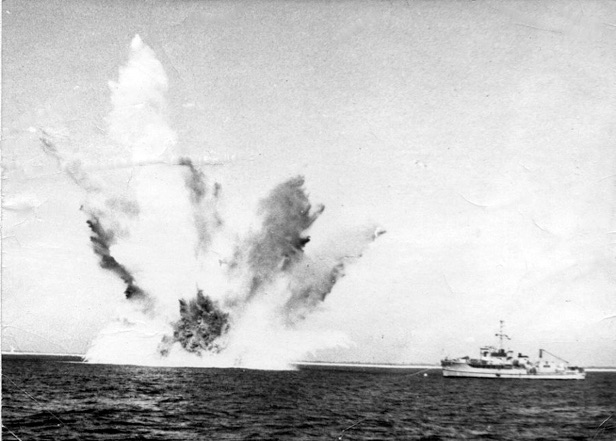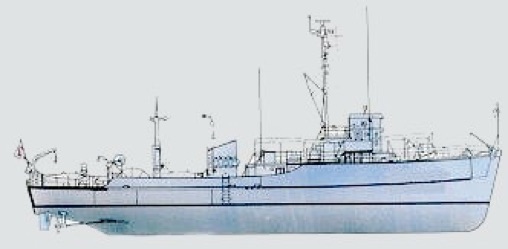Unidentified
Yard Class
Minesweeper

Unidentified
Yard Class
Minesweeper
The first “Yard class Minesweeper (YMS)” was built in the Henry B. Nevins Inc. Shipyard, in City Island, New York. The keel of the YMS-1 was laid March 4, 1941 and she was launched on January 10, 1942, but completely finished two months later on March 25, 1942.
A total of 561 minesweepers were built for the war with 481 serving the US Navy and 80 serving the British (BYMS).
The length of the YMS class boat is, 136 feet, beam 24 feet 6 inches, Draft 8 feet (6 foot 3 inches for the 359), and they displaced 270 tons. With their two 880 BHP (Brake Horsepower) General Motors diesel engines (2 shafts) they could reach speeds up to 15 knots. The armament consisted of, one 3” .50 caliber gun mount, two 20 mm guns, and two depth charge projectors.
The 481 minesweepers serving the US Navy had generally the same characteristics, with the only variation being one of appearance. YMS-1 through 134 had two stacks, 135 through 445 along with 480 and 481 had one stack, while YMS-446 through 479 had no stack.
Originally rated as service craft, the minesweepers were used during WWII for inshore sweeping to prepare the way for amphibious assaults.

It is true nothing happened by the way of naval action without the aid of the minesweeper. Without them no sea bound invasion could have taken place until the path had been cleared of all mines. The minesweeper also had the hazardous task of removing these unseen killers. With this, the minesweeper crew had a motto, “…wherever the fleet goes, we’ve been!”
The YMS-class mine sweeper not only enjoyed the greatest number of units built to a common design, but managed to serve every Allied Navy from 1942 well into the late 1970s. Nearly a quarter of all ship losses in WWII were caused by mines, thus reinforcing the minesweepers importance. Every minesweeper crewman endured extraordinary dangers making navigable waters safe, and although little recalled today, the minesweeper’s role in naval warfare was the reason so many YMS class had to be built and deployed from the Aleutians to Cape Horn.

First side scan imagery was done by Bob Mester of Underwater Admiralty Sciences.
This minesweeper is still undergoing further exploration to ascertain its identification.




-Home